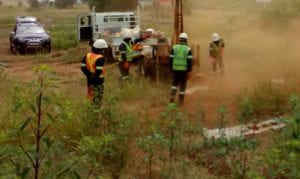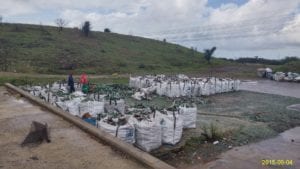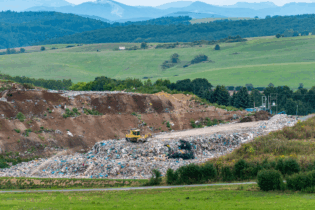Landfill site problems are often bigger than the eyesore created by the huge piles of waste. At one point or another, landfill sites will have to be closed. While this may seem like the end of the story, it is only the beginning of the next chapter in the life of the landfill.
By: Liesl Frankson Effective landfill remediation poses a challenge for both public and private entities. Navigating the regulatory process, coordinating the different phases of the project, and establishing a long-term plan for post-closure reuse are only the beginning. Landfills are usually designed with a specific lifespan in mind, which is often determined by the volume of waste they can handle. Once they have reached the end of their lifespan, and have been filled to capacity, they must be closed and decommissioned, as stipulated in the Waste Management Licence. Nicolas Vanhecke, Practice Lead: Remediation Services, and Soleil Jones, Environmental Scientist, at AECOM Africa, an integrated infrastructure delivery firm, note that landfills may need to be closed for a number of other reasons. There may be unacceptable environmental impacts such as groundwater pollution, and/or unmanageable air pollution such as dust or odours. In many instances, improving management and operations would be a necessary first step, but if this process is unsuccessful, closure is necessary. “There may also be an issue with the geological conditions – for example, if the landfill is located on dolomitic ground conditions, and is not being managed so as to prevent water ingress, there is a risk of sinkholes forming,” Jones and Vanhecke explain.The closure process
 The process of landfill closure and remediation is legislated by the National Environmental Management Waste Act (NEMWA), the Water Act and the Waste Management Series, as promulgated by the Department of Water Affairs and Forestry (now the Department of Water and Sanitation).
This process entails capping and decommissioning, and includes a number of different factors. While it might seem that the process of closure only begins once the landfill has reached the end of its useful life, there are factors that can be maintained and attended to while the site is still operational.
Jones & Vanhecke highlight that the controlled, planned, and systematic filling of landfill cells should be carried out with progressive closure and rehabilitation as cells gradually fill up throughout the life of the landfill.
The process of landfill closure and remediation is legislated by the National Environmental Management Waste Act (NEMWA), the Water Act and the Waste Management Series, as promulgated by the Department of Water Affairs and Forestry (now the Department of Water and Sanitation).
This process entails capping and decommissioning, and includes a number of different factors. While it might seem that the process of closure only begins once the landfill has reached the end of its useful life, there are factors that can be maintained and attended to while the site is still operational.
Jones & Vanhecke highlight that the controlled, planned, and systematic filling of landfill cells should be carried out with progressive closure and rehabilitation as cells gradually fill up throughout the life of the landfill.
“The slopes of the waste body must be resolved to ensure they lie at a safe angle, which should be maintained throughout the operational phase, after which capping is carried out by means of an engineered liner,” they say.Furthermore, Jones notes that all stormwater run-off must be diverted away from the waste body to separate clean and dirty water circuits, and to prevent leachate soaking into the waste body, and subsequent groundwater pollution and odours.
Considering environmental impacts
“Once the waste body is capped, it must be revegetated to prevent dust from impacting the air quality in the wider area,” Jones adds. “The site must also be fully secured, and access-controlled, to prevent trespassers entering the site. For example, there could be an issue with people re-mining the waste body for recyclables, which presents a fire risk, as well as allowing rainwater to enter the waste body, which causes groundwater contamination and odours.” Jones says that, in the past, little to no consideration was given to the potential environmental impacts of landfills on human health and the larger environment, which is why today’s landfills are licenced, and with very specific engineering design. “Even with closures, environmental assessments need to be conducted, which often include monitoring for a specified time at a specific frequency.”The remediation process
 The remediation process is dependent on a number of factors, including the type and classification of the waste, as well as the size of the landfill. Most of the time, the remediation process consists of waste re-profiling; capping, usually with topsoil such as clay or with a geotextile; revegetating, usually with indigenous grass; and finally closing.
Vanhecke notes that, once properly remediated, the landfill site could be used for anything from parkland to recreational infrastructure or even grassland, depending on the preference of the landfill owner, the surrounding community, and the regulatory authorities.
Some successful international examples of remediated landfills in urban areas include the London Olympic Stadium (2012), the Milan Universal Expo (2015), and the Confluence neighbourhood of Lyon in France, which is one of the biggest landfill rehabilitation projects in Europe.
The remediation process is dependent on a number of factors, including the type and classification of the waste, as well as the size of the landfill. Most of the time, the remediation process consists of waste re-profiling; capping, usually with topsoil such as clay or with a geotextile; revegetating, usually with indigenous grass; and finally closing.
Vanhecke notes that, once properly remediated, the landfill site could be used for anything from parkland to recreational infrastructure or even grassland, depending on the preference of the landfill owner, the surrounding community, and the regulatory authorities.
Some successful international examples of remediated landfills in urban areas include the London Olympic Stadium (2012), the Milan Universal Expo (2015), and the Confluence neighbourhood of Lyon in France, which is one of the biggest landfill rehabilitation projects in Europe.
“If the site is smaller, site reclamation can be conducted via an excavation-transfer-treatment process,” Vanhecke highlights. A key element in site reclamation is the transformation of anaerobic to aerobic conditions in the landfilled waste. Depending on the waste accumulated in the landfill, a methane gas plant can be installed to recuperate methane for energy purposes.
Post-closure monitoring
Following closure and remediation, the landfill site is subject to a post-closure monitoring period, which is recommended for up to 30 years, according to Vanhecke. This is in order to monitor the integrity of the capping, and the impact of the quality of the groundwater quality in and around the waste body. “There may also be a need for ongoing pumping and treatment of the leachate that gathers in the leachate collection system. The landfill will also most likely require a methane management system, whether that be done by landfill gas harvesting, or regular flaring, so as to prevent methane build-up, fire risk, and air pollution,” Jones adds. Adherence to legislation is key, and therefore a preliminary closure plan and end-use options for the landfill should be outlined from the outset of the project, and addressed ideally in the Environmental Impact Assessment phase.“Financial provision must be made for these engineering works and materials, and a more detailed rehabilitation and closure plan must then be developed once the landfill operations commence,” Vanhecke concludes.5 Tips for managing risks around landfills
- Invest in proper access control, training and health and safety provisions for staff and the public.
- To manage pollution, ensure sufficient stormwater berms, channels, contaminated run-off collection systems and leachate management systems are available for the construction, operation, decommissioning and post-closure phases of the landfill.
- Implement proper waste classification and control during the operational phase to reduce disposal of unsuitable or prohibited waste types that present a risk to groundwater quality.
- Manage the acceptance and disposal of waste in a planned and systematic manner. Do not be haphazard in the landfill operations.
- Maintain the buffer zone around the landfill – i.e. do not allow development or encroachment on these areas – otherwise there could be liability risks down the line, not to mention impacts to human health.










